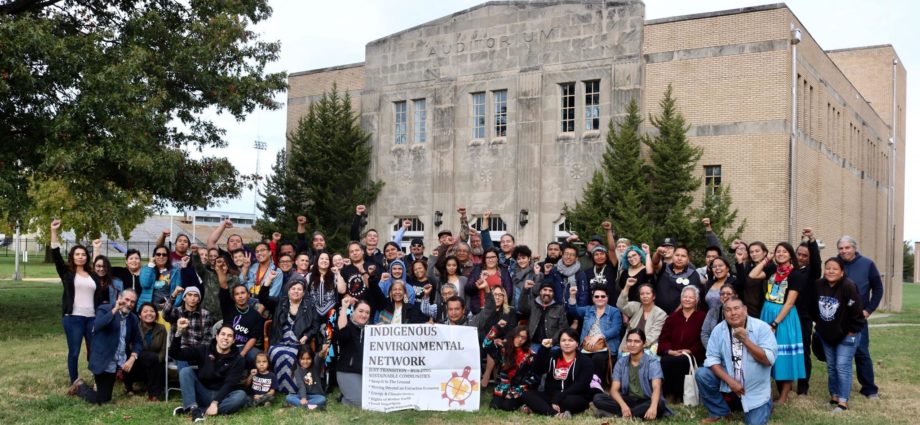On October 22nd 23rd, and 24th 2019, Haskell Indian Nations University hosted the Indigenous Just Transition Assembly organized by the Indigenous Environmental Network (IEN). Over 100 Indigenous leaders and organizers from around the country met to discuss the importance of making a Just Transition from an unfair, capitalistic, and carbon-based economy to one that is ecologically sustainable, equitable, and just. There are many goals and principles being strived for. The following exemplifies some of the main issues being discussed.
- Indigenous-based green economy
- Native energy justice and democracy
- Clean energy and energy efficiency
- Green, affordable, and energy efficient homes
- Community-based health care and healing centers
- Sustainable community-based planning
- Ecosystem restoration
- Meaningful work and localized community-building jobs
IEN is a grassroots organization that was established in the 1990’s by Indigenous people and other individuals to address environmental and economic justice issues. Since then, there have been annual meetings across the continent. The framework and policies brought forth are meant to be implemented for all communities but is especially tailored for Native communities. As a group of people who have been severely oppressed by a profit-driven, growth-dependent and industrial society; we are responsible for acknowledging the need for a local, tribal, national and global shared-vision towards a new economy based on living in balance with the natural systems of Mother Earth.
Tom Goldtooth, coming from the Dine Nation of Arizona and also Bdewakaƞtoƞwaƞ Dakota of Minnesota, is the executive director of IEN. Along with many others, he was paramount in establishing the IEN in 1996 and organizing the assembly at HINU this year. He was able to answer some questions and provide some words of wisdom.
How long have you been with IEN?
I was recruited by environmental youth and elder organizers in 1991, the year after the grassroots idea of environmental justice was formed. Winona LaDuke was one of them that came to talk to me. There was a leadership summit in Washington D.C. [and] they invited me to where many people were working to make a network of Indigenous people for environmental justice. I was working as a director of Environmental Protection for an Anishinaabe tribe at the time. At first, I refused to go the conference because the work is with the people and I did not want to work at the international level. [Winona] convinced me and I am really glad she did because I met a lot of really good [grassroot organizers]. So, in 1996, we finally hired our first staff for IEN and that was me.
How well do you think this assembly went for the Just Transition aspect?
I am really impressed with the assembly. I am mindful and respectful of the diversity within Indian Country. It’s like the tree of life where every leaf is unique. So doing anything on the scale that we envision is tricky. There are many questions involved. This was actually the first gathering where we were able to invite a cross-representation of different people. I feel really good: people are ready to engage and make movements to make a change for the future; to see what the plan is for our Indigenous communities. I am especially grateful to see the younger generation articulating the importance of, not only the work we are doing now, but also the teachings handed down by our elders.
What are some plans for the Indigenous Environmental Network?
As IEN, we are definitely going to keep listening and building the network. On a community level, we want to develop a community based and driven training toolkit on Just Transition principles, so tribes can be self-sufficient. This calls upon decolonization. For academic spaces, we want to make a curriculum for tribal colleges and see that students are more involved and educated about the importance of Just Transition.
Was this meant to be a nationwide movement or community-based?
I think the concept of how the “spokes and wheels” is put together should happen organically. This will happen with continual assemblies and conferences like what has happened here. Historically we have not been able to have our own voice because of colonization. Many policies have imposed their governance over us without any consultation. Now we are trying to go back to the tradition of how our tribal leadership used to operate; one aspect to that is instead of individuality thinking, we need to think as a community. The internalized oppression we experience can sometimes cause us to be our own worst enemies. So starting with healing ourselves then reaching out to the community is the idea. Eventually other people from other communities will follow suit. This has already been happening. But the work is not over.
Do you have any advice for younger generations?
The biggest thing is reaching out to others and having an open dialogue on what needs to happen. That would include reaching out to other students and seeing what they are thinking about and even reaching out to school leaders like Dr. Dan Wildcat. It would be tremendous to encourage a student working group on an Indigenous-based Just Transition. Me and IEN members are willing to come back [to HINU] and help in any way we can. As stated before, there were many different people from diverse backgrounds who were able to participate in this assembly. Siqaniq Maupin, from the Inupaiq tribe, came all the way from Fairbanks, Alaska. She was able to answer some questions about the event.
When it comes to social change, what are some things you are most passionate about?
One of the biggest things is seeing more equitable living in Indigenous communities. Since I was young, I struggled in poverty. When you grow up in that kind of environment, there is this ripple effect that is transferred to mental health and other aspects of living. When I hear about how my ancestors lived, where they didn’t have to worry about murder, abuse or struggling paycheck to paycheck; that’s what I’m most excited about that my kids or grandkids can live that reality.
How was your time at Haskell Indian Nations University?
It was really good. I actually almost applied here when I was younger but ended up not going for it. So coming to this campus and being at a different time in my life really reminds me of where I am and where I have come from. It is also really inspiring to see this campus, once used to dismantle our culture, now being used to empower it.
How was the experience of Indigenous Just Transition Assembly for you?
The experience has been really great. I was excited to be on a tribal campus because most of the conferences I attend are held at a bigger conference or a hotel. Here I was able to be with students and the Indigenous people of this land. So, I think just having it in a place where it’s more equitable and grassroots makes a difference in the atmosphere. Also seeing a lot of people who have made a difference in Indigenous rights with the youth and elders, was more impartial than I have seen in other Just Transition circles.
Are there any other organizations that you are also a part of?
Yes, there are many (laughs). I am a committee organizer with Native Movement, which is a grassroots nonprofit that helps uplift marginalized and Indigenous voices in Alaska. There are many others I am a part of but that is the main one.
What are the next steps for you when it comes to the principles of Just Transition?
I have been really inspired to do more with the community I am currently in. Also trying to support more of the organizing that is already happening there. For instance, I am considered an urban Native. So instead of trying to become the perception of what “Native” is supposed to be, I would like to reach out to others who feel just like me and finding a collective voice. My next step is to start doing more grassroots organization in my community even if that’s not in a traditional sense.
Based upon your experience, is there any advice for Indigenous youth who would like to be a part of grassroots organizations?
For me, when growing up I have always felt things were wrong almost every day of my life. Seeing the injustices I would see happen… I realized we all have the power to do something about it. Whether you live on your traditional land or not, are Indigenous or not, a person of color or not; you have strength. There is strength in your voice and words. You can do what other people who are being uplifted on social media platforms are doing. There are people all around the world doing this work. Even though they may not be shown in the light, they are making a significant difference. So, don’t think it’s unattainable to be where [leaders and organizers] are.
On the last two days of the assembly, the It Takes Roots (ITR) organizers held the spotlight to speak about their concerns on what it will take to achieve a Just Transition. [The] ITR movement is a collaboration between various grassroots organizations from around the country. These include the IEN, Climate Justice Alliance (CJA) and the Grassroots Global Justice Alliance (GGJ). From the IEN website, ITR is described as: “…a multiracial, multicultural, multi-generational alliance of networks and alliances representing over 200 organizations and affiliates in American Indian traditional and tribal Native lands in U.S., grassroots organizations from all 50 states, First Nations in Canada, and front line community groups in the provinces, and territories which are led by women, gender nonconforming people, and peoples of color, which is the outcome of years of organizing and relationship building that addresses our diversity and unique cultures.”
The collaboration started with the organizing for the People’s Climate March in 2014 and still continues. Last year, It Takes Roots participated in IEN’s Protecting Mother Earth Conference in Nisqually, WA. It is very important to see collaborations like this to continue pushing for Just Transition Principles.
These past few years have seen many pushes by grassroots organizations like IEN, CJA, and GGJ against the systemic principles imposed upon us. The assembly that was held at HINU is one step toward transitioning to the Indigenous principles we have set for ourselves. Even though it will take much more work within respective communities, the continued discussion on our corresponding goals will make all the difference. There are many networks and organizers who are more than willing to help in the struggle to restore our indigenous lifeways of responsibility, duty, and respect to the Mother Earth. As we begin to lift each other up and make sure everyone is on the same page, things will begin to fall into place. If there is one thing to take from this assembly, it is that you are more than able to do your part in providing to your community. There are countless people working every day to make sure our people thrive for many generations to come.

Featured image by Jennifer Falcon, IEN

